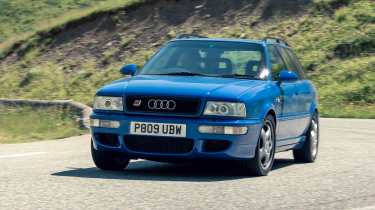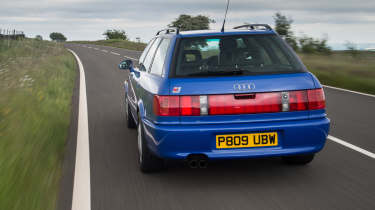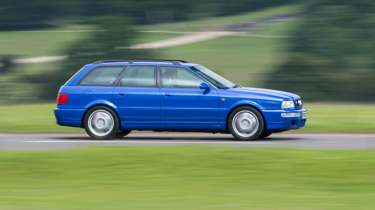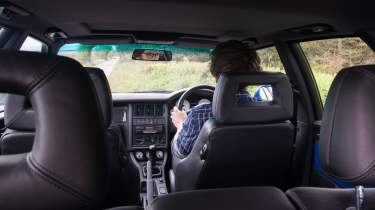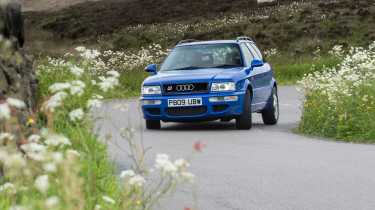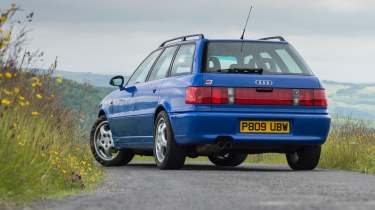Used Audi RS2 (1994) review – an unsung '90s hero you can own for £40k
The RS2 set the template for fast Audis to come as the original RS – revered then and a cult classic now
You’ll have been lucky if you’ve ever seen an Audi RS2 in the metal – just 180 right-hand-drive examples were built, and not all of those came to the UK. But it was this rare Porsche-developed model that laid out the blueprint for generations of much higher-volume RS4 and RS6 Avants – genesis of the fast Audi as we’ve come to know it today.
Fast estate cars were nothing new in 1994 but the RS2’s four-wheel drive and tractable turbocharged five-pot motor endowed it with easily accessible, all-conquering performance that – ironically – gave 911 drivers sweaty palms. Deploying 315bhp through its Torsen-based all-wheel-drive system, the RS2 stops the clock at 4.8sec in the sprint to 62mph and goes on to a 162mph top speed – faster than any other estate car at the time.
With time it’s gained cult status, not only because of its rarity, performance and Porsche kudos, but because the RS2 is beautifully built and endearing to drive. Not quite an E30 M3 killer, but interactive and full of '90s charm. It’s one of Audi’s performance car greats, and a surefire evo icon.
History and specs
- Audi’s first RS model, developed with help from Porsche
- More powerful than a Ferrari 348, and as quick to accelerate as a contemporary 911 Carrera
- Followed the five-cylinder footsteps of the mighty Quattro
Today, if you said the sixteenth letter of the alphabet followed by the first positive integer to a roomful of car enthusiasts, most would instantly think of McLaren’s hypercar. And with good reason. Some, however, would undoubtedly think of the Prodrive-tuned GC8 Subaru Impreza. A few might even connect it with the supercar club that Damon Hill helped set up a while ago. But long before all of these there was the Audi RS2, and I think it can reasonably lay claim to having first dibs on the now well-known nomenclature. Why? Because while it was being developed in the early ’90s, the RS2 was known internally at Audi as ‘P1’.
The ‘P’, of course, stood for ‘Porsche’. Ferdinand Piëch, then head of Audi’s supervisory board, realised that his Ingolstadt engineers were far too busy developing the important new A4, A6 and A8 models to be distracted by a niche project like the RS2, but nonetheless he wanted his idea for a really fast estate car to come to fruition. Turning to Porsche, where Piëch had worked during the ’60s and early ’70s, was the obvious solution. Call it payback for Audi building the 924 and 944 for Porsche.
Looking around the car and you’ll notice how many bits are obviously from the Zuffenhausen toy cupboard, like the door mirrors. Slightly too small for the car, their 911 shape acts like a catalyst, opening your eyes to all sorts of other Porsche parts. The front bumper, with its indicators and sidelights, is suddenly an obvious refugee, as are the five-spoke 17-inch Carrera Cup wheels, which have such a distinctive Porsche design. Look closer still and you see that the brake calipers actually spell it out for you with the seven white letters on a red background. The name is also there, in even smaller letters, on the badges on the front grille and the tailgate. Interestingly, this first Audi RS badge also separates the ‘R’ from the ‘S2’, denoting that this is very much the Renn version of Audi’s pre-existing S2 model.
The lowlier model had 230bhp and 258lb ft, and although the same basic 20-valve in-line five-cylinder engine remained, Porsche badges greet you once more when you lift up the bonnet on the RS2. Hotter camshafts and a 30 per cent bigger KKK turbocharger puffing at 1.4bar (up from 1.1) were perhaps the biggest changes, although a new Bosch engine management system, new injectors, a more freely flowing exhaust manifold and a bigger intercooler all played their part too. The end result of all this fettling was that Michael Hölscher, who oversaw the project and would go on to work on the Carrera GT, exceeded the target set for him of a 30 per cent increase in power, the final figures reading 315bhp at 6500rpm and 302lb ft at 3000rpm.
The now famous Nogaro Blue paint is distinctive but not lairy… unlike the blue Alcantara inside. Open the door and you are exposed to what can only be described as a very arresting interior. The options were full black Nappa leather with wood veneer, silver Alcantara with carbonfibre, or 'the blue'. Initially it’s overwhelming in its vibrancy, but look closer and there are some lovely details, such as the very subtle blue strands that run through the weave of the glossy carbonfibre.
As just 180 units of 2900 came with the wheel on the right-hand side, the RS2 is a rare beast. Incidentally, Audi originally intended to produce only 2200 RS2s, but such was the car’s popularity that it eventually increased that number by 700.
Driver’s note
‘Get rolling and it’s a tighter, more cohesive car than an early Quattro. Better supported on its suspension, with heavier steering and a weightier, more precise gearchange. By ’90s standards it’s firm riding but still nicely judged for the road – as you’d expect with Porsche tuning the dampers and roll bars.’ – Yousuf Ashraf, evo senior staff writer.
Performance, ride and handling
- Old-school turbo engine needs revs on the board to wake up
- Stable and reassuring rather than fun
- Narrow body, slim pillars and manual ‘box are refreshing callbacks to the '90s
Get in and you find that the Recaro, with its very period rectangular headrest, is set a little high but clasps you reassuringly about the ribcage. Twist the key and the RS2 comes to life with a dry, high-pitched clearing of its throat before settling to a bassy but relatively demure idle. The wheel is quite an attractive airbag item but some of the early cars came with an even simpler looking Procon-Ten three-spoker (Procon-Ten was a cable-operated system that, in the event of a crash, pulled the steering wheel towards the dash while simultaneously tightening the seatbelts).
The RS2’s cabin feels wonderfully light and airy. All-round visibility would hardly be better if you were at the top of a lighthouse. It’s worth taking it gently for the first few miles, warming fluids through thoroughly, stretching things gradually and gently, like a runner going for a tentative first jog a few days after a marathon. The gearshift is certainly happy not to be rushed. The lever springs easily out of gear, giving it an initially very light action, but then you need to pause very slightly before pushing very deliberately through some resistance in order to slot it into the next ratio.
This is turbocharging the old-school way, and at low revs the response is a bit limp – the fireworks only come when you hang on to gears for longer and sink deep into the throttle. At 3000rpm the motor wakes up, and then from 4000rpm the delivery becomes a fervent rush, building to a smooth rasp overlayed by turbo flutter when you lift for the next gear. At full noise the RS2 is a seriously fast car and the motor is wonderfully strong. Third and fourth gears are where it seems to do its best work, the forced-induction surge lasting long enough to impress and be enjoyed. Interestingly, it’s not until relatively high in the rev range that warbling vestiges of Audi’s distinctive five-cylinder soundtrack really come alive.
The hugely long travel of the throttle pedal takes some getting used to. Most modern cars seem to require only the first third of the available travel to extract all their performance, but even by 1995 standards the RS2 requires a remarkably full extension of the right leg to wring the last from the engine. When you do reach the carpet, however, you feel very committed to the formidable acceleration you’ve summoned up.
The ride is interesting. A firmness over smaller bumps is immediately apparent and quite surprising for a car of this vintage. However, just as you’re getting accustomed to this and thinking it’s all going to be tightly controlled, a bend in the road pops up and reveals a goodly amount of body roll. The steering is relatively weighty, although it does lighten up a bit when you push on. Sadly, feel is noticeable only by its absence.
The RS2’s grip really does feel unimpeachable even under fairly severe provocation with the throttle. It’s not a total understeer-fest as Audi-haters might have you believe, but equally it doesn’t feel like you’d ever get the car into that perfect window of mild-oversteer balance that the best four-wheel-drive performance cars excel at. Things might be different if the surface was wet or if you could throw a lot more speed at it on a circuit, but on a dry road the RS2 and its Torsen-based quattro system is dogged in its security. This actually becomes hugely impressive through faster corners, the whole car leaning more than expected but also displaying a tenacity that is bewildering given the tyres it’s on. Speaking of which, they’re Dunlop SP Sport 8000s in a 245/40 R17 fitment.
On the transmission tunnel is something that looks like it might enliven proceedings. On a graph-paper grid is drawn a pair of connected axles, with the word ‘Diff’ on the button below. Press it and you engage an electronic diff lock on the rear axle. However, before you get too excited, you are only meant to engage it at a standstill when you have found yourself in particularly slimy, sludgy, sandy or snowy conditions and might otherwise struggle to get moving. Trundle along above 15mph and the lock will automatically disengage.
An E30 M3 is lighter on its feet, sharper and more modern, but the RS2 is a deeply desirable car, in some ways unexpectedly so. Much better resolved than earlier Quattros, it encapsulates everything we love about fast Audis (and a few things we don’t, admittedly). It oozes exclusivity and instils a lust in people that very few cars, and even fewer estates, ever have. For that reason it will always remain a legend.
Driver’s note
‘The RS2 is satisfying and involving, but dig deeper and some undesirable Audi DNA comes through. With the engine ahead of the front wheels the nose doesn’t snap into line crisply and always gives up grip before the rear, and there isn’t much you can do to shift the balance the other way, even with a big mid-corner lift.’ – Yousuf Ashraf, evo senior staff writer.
What to pay
Today, time-warp right-hand-drive examples can fetch over £70,000, but be patient, watch the auction sites, and you could pick up a well-maintained example for £40k or less. If you can live with left-hand drive, there’s time and money to be saved by considering an import.
Like other Audis of the period the RS2 is robust. The cambelt needs changing at 80,000 miles and with regular servicing the engine shouldn’t cause any issues. Replacement brake components can be pricey (the system is borrowed from Porsche’s 968 Club Sport) and by now most RS2s will need a suspension refresh to restore their original handling and ride quality. Given that the model’s all-weather ability is key to its appeal, it’s likely that many will have been used during winter months, so check for excessive corrosion. Bubbling can appear on the rear quarter panels, and it’s worth checking the underbody too – if the rust is only surface level, it can be ground back and treated with an inhibitor.
Audi RS2 specs
| Engine | in-line 5-cylinder, 2226cc, turbo |
| Max power | 315bhp @ 6000rpm |
| Max torque | 302lb ft @ 3000rpm |
| Weight | 1595kg |
| Power-to-weight | 201bhp/ton |
| 0-60mph | 5.4sec (claimed) |
| Top speed | 163mph (limited) |
